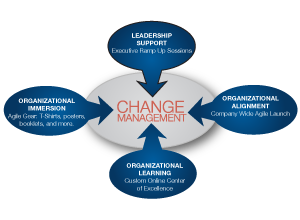Why Agile Values Must Permeate an Organization
These days most of the discussion around Agile is focused on process, frameworks, workflow, and efficiency. And that’s ok, these are all important aspects of what Agile is all about and the value it can bring to an organization.
But in all these discussions, it can unfortunately become easy to forget the manifesto that started the entire Agile revolution was about a set of values rather than a process. By looking back at this short and simple list of values, we can clearly see how Agile can really permeate an entire organization rather than just a project team.
The Agile Manifesto
Back in 2001, a small group of software engineers got together at a ski resort in the mountains of Utah to discuss their common frustrations. They were frustrated with the constant battle between developers (who were creating software for end users) and the corporate bureaucracy and management philosophies that seemed to inevitably stand in the way of that goal, despite their claims otherwise.
What came out of that three-day conference was a set of values these engineers felt embodied a streamlined, properly prioritized way of looking at software development: The Agile Manifesto:
We are uncovering better ways of developing
software by doing it and helping others do it.
Through this work we have come to value:
Individuals and interactions over processes and tools
Working software over comprehensive documentation
Customer collaborationover contract negotiation
Responding to change over following a plan
That is, while there is value in the items on
the right, we value the items on the left more.
Since then, this simple collaborative set of priorities has gained tremendous traction – first in the world of software development, but now in all manner of industries and applications.
Adopting Agile Values Organization-wide
As noted by Jim Highsmith, one of the original authors of the Manifesto, “At the core, I believe Agile Methodologists are really about “mushy” stuff like delivering good products to customers by operating in an environment that does more than talk about “people as our most important asset” but actually “acts” as if people were the most important, and lose the word “asset”. So in the final analysis, the meteoric rise of interest in and sometimes tremendous criticism of Agile Methodologies is about the mushy stuff of values and culture.”
With that ideal in mind, it’s easy to see how “going agile” requires a cultural shift inside the organization, as opposed to just a change of processes to include a daily Scrum meeting or other agile practices.
While the most visible effects of this cultural change can be seen in the way products are developed and released, the ripple effect can be seen in HR, in IT, up as high as the C-suite of executive offices and throughout every professional interaction.
For example, a company that truly adopts agile values across the board is going to review and adjust their schedule of meetings based on what’s actually necessary and productive as opposed to just going through the process for process’ sake. This is an application of the “individuals over processes” value, and it will likely result in shorter, more productive meetings and more time for actual work to be accomplished.
With a company-wide priority placed on collaborating with the customer and constantly improving the product(s) being released, everyone in the organization will become more focused on high quality production, excellent customer service, and open communications – all of which translate directly to the bottom line through more sales, more profit, and greater customer loyalty.
Likewise, a company-wide commitment to adaptation rather than strict plan adherence can make even the largest bureaucratic behemoth more Agile – a talent that’s proven to be necessary for survival in the lightning quick commercial environment of today.
Fifty years ago a corporation could survive indefinitely by numbly repeating production. Today’s organization simply cannot compete without being able to adjust on the fly and quickly adapt their entire way of doing business as changes occur.
If your company is eager to take on this challenge, you’ll benefit from the expert guidance of our agile change management services . Take a look and let us know what you think.



